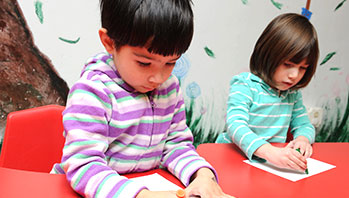- chart paper
- glue
- markers (blue, green, orange, purple, red, yellow)
- paints (blue, red, yellow)
- paint brushes
- paper plates
- color rectangles (2 each color: blue, red, yellow)
- color square (1 each color: green, orange, purple)
- color
- mice
- mix
- paint
- puddle
- stirring
MA Standards:
Speaking and Listening/SL.PK.MA.2: Recall information for short periods of time and retell, act out, or represent information from a text read aloud, a recording, or a video (e.g., watch a video about birds and their habitats and make drawings or constructions of birds and their nests).
Head Start Outcomes:
Language Development/Receptive Language: Attends to language during conversations, songs, stories, or other learning experiences.
Language Development/Expressive Language: Engages in communication and conversation with others.
Language Development/Expressive Language: Uses language to express ideas and needs.
PreK Learning Guidelines:
Science and Technology/Inquiry Skills 4: Record observations and share ideas through simple forms of representation such as drawings.
Draw and Write Together: Color Mixing Chart

© Commonwealth of Massachusetts, Department of Early Education and Care (Jennifer Waddell photographer). All rights reserved.
STEM Key Concepts: There are many different colors; Two or more colors can be combined to make a new color
ELA Focus Skills: Speaking and Listening, Vocabulary
Educator Prep: Cut two, same-sized rectangles of each color: blue, red, yellow. Cut a square for each color: green, orange, purple. To determine the size of the squares, overlap two of the rectangles and cut the square to fit the overlapping corner.
Use the book Mouse Paint by Ellen Stoll Walsh to help children create a simple color mixing chart. Act out stirring and dancing as you say, Let’s make a chart to show what happens when the mice mix colors by stirring and dancing in the puddles of paint.
- Show the illustration of the red mouse dancing in the yellow puddle. Say, The red mouse is stirring the yellow puddle with his feet. What color does he make? Wait for children to respond and then turn the page and point to the orange puddle.
- Say, Let’s make a chart about how we mix different colors to make a new color. Glue a red rectangle and a yellow rectangle on the chart so that one red corner overlaps one yellow corner. Point to the overlapping corner and ask, What color do you make when you mix red and yellow? If children have difficulty naming the new color, ask a volunteer to mix the colors together on a paper plate. Once the color is identified, have a volunteer glue the orange square in the overlapping area.
- Continue with other combinations of color, drawing on children’s previous explorations. Throughout the week, encourage children to identify objects that are orange, green, and purple and add them to the chart.
Adaptation: Challenge older children to create color books showing the colors created by mixing two primary colors together (orange, green, and purple).
